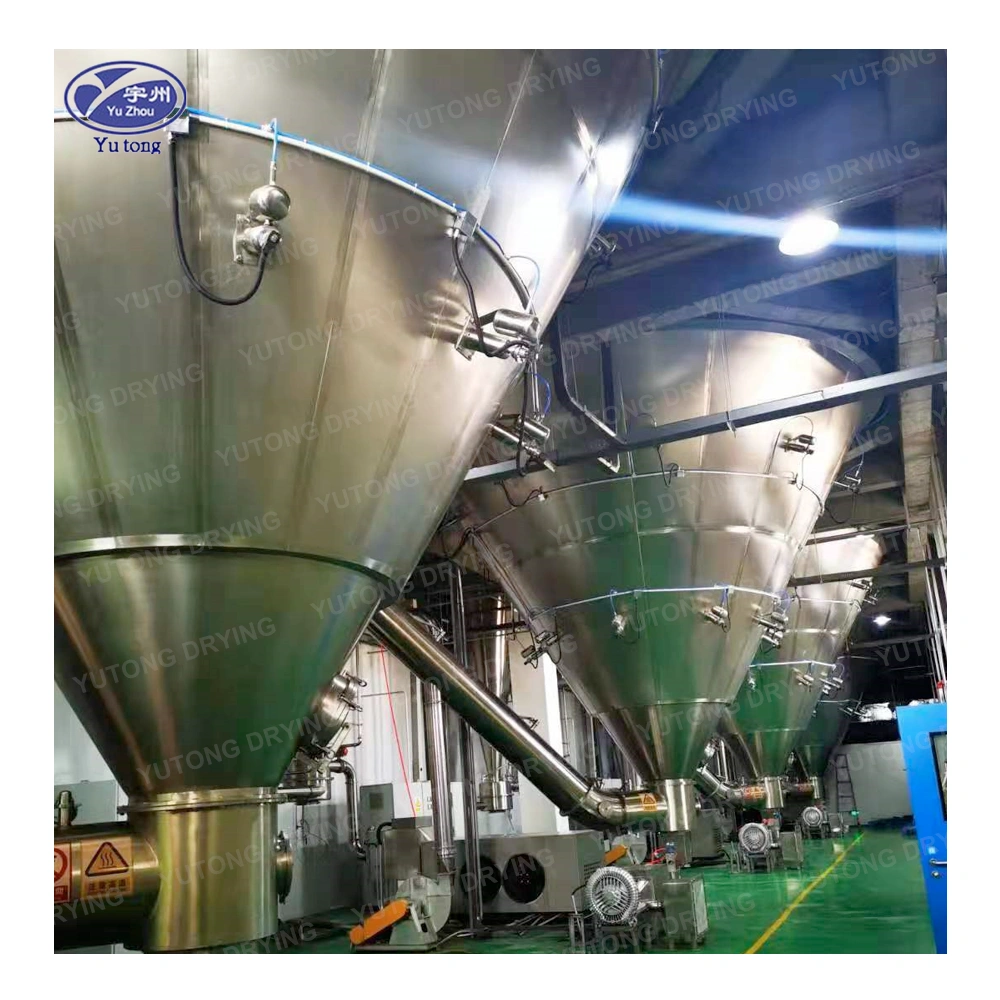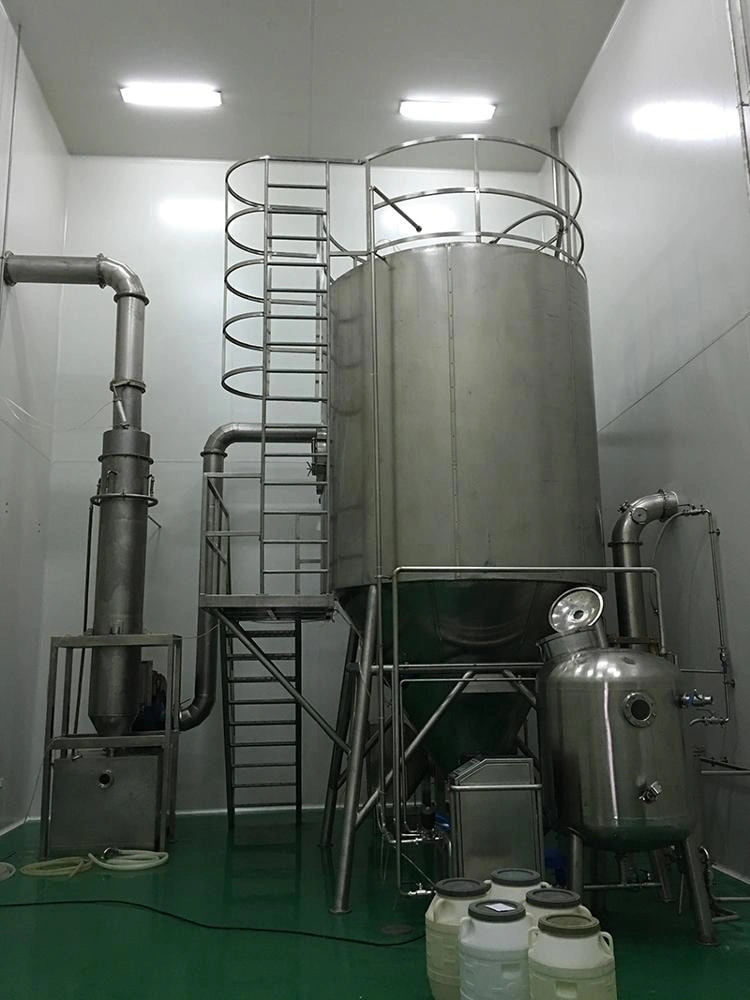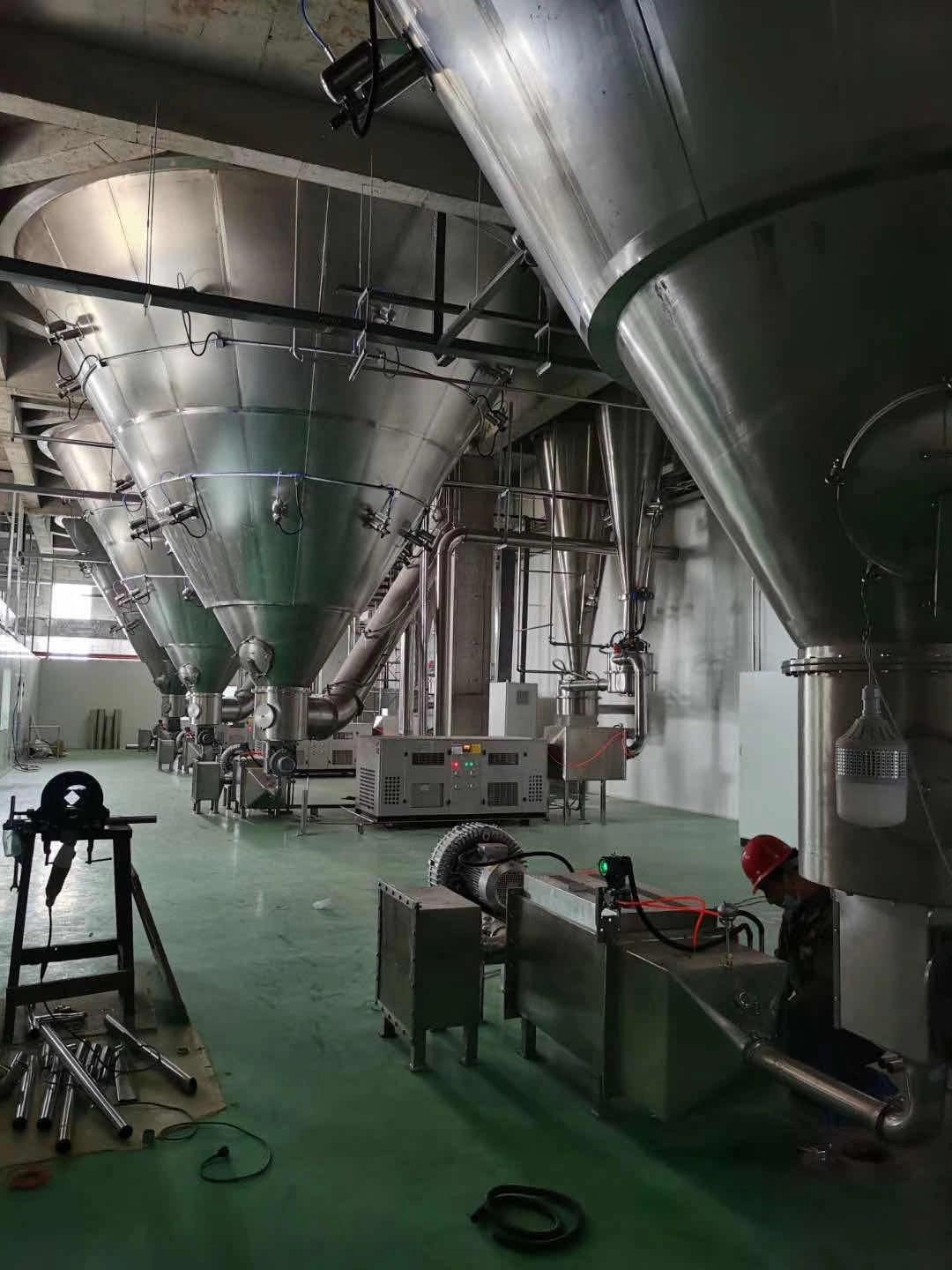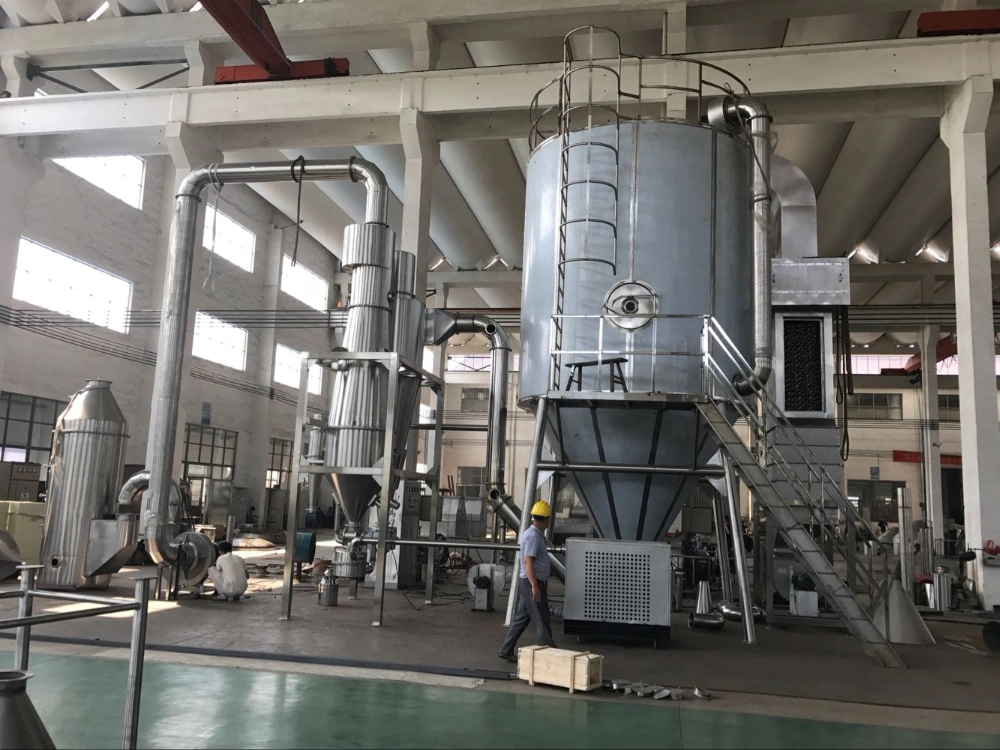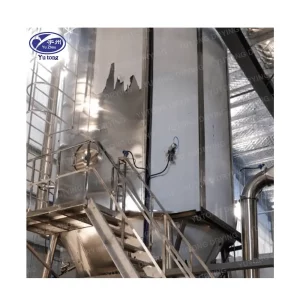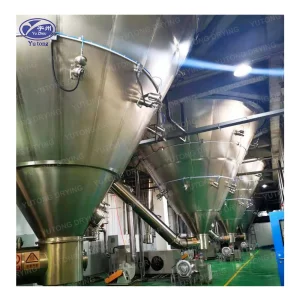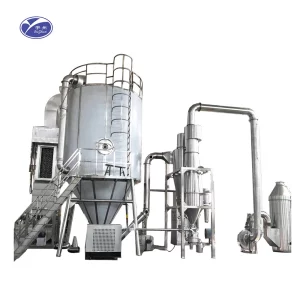Table of Contents
Product Detail
Regular maintenance of a spray dryer is not just about keeping it operational. It’s about ensuring product quality, enhancing efficiency, and reducing operational costs. Proper maintenance can prevent unexpected breakdowns, which often lead to significant repair costs and production delays.
Ensuring Product Quality
Consistent product quality is a primary goal for any manufacturing process involving spray drying. Regular maintenance helps in maintaining the integrity of the process, ensuring that the end product meets quality standards. Consistent temperature control, proper airflow, and regular calibration of sensors are critical factors that are directly influenced by maintenance routines. When these elements are kept in check, the final product remains reliable, maintaining the brand’s reputation and customer satisfaction.
Enhancing Efficiency
Efficiency in spray drying operations translates into lower energy consumption and reduced wastage. Proper maintenance ensures that the equipment functions at its peak efficiency, minimizing the energy required to achieve desired outcomes. Routine checks can reveal inefficiencies, such as leaks or blockages, that may cause the system to work harder than necessary. By addressing these issues swiftly, operators can ensure smoother operations and cost savings.
Reducing Operational Costs
The financial implications of regular maintenance are significant. By investing time in preventive maintenance, operators can avoid the high costs associated with emergency repairs and unexpected downtime. Over time, this proactive approach results in substantial savings, as the equipment runs longer without significant interruptions. Furthermore, with fewer breakdowns, the need for costly spare parts and labor is reduced, making the operation more economically sustainable.
Common Spray Dryer Problems
Spray dryers, like any other machinery, can face issues if not properly maintained. Here are some common problems you might encounter:
Excessive Noise
If your spray dryer is making unusual noises, it might indicate a mechanical issue. Common causes include loose components, worn-out bearings, or misaligned parts. Addressing these issues promptly can prevent further damage.
Identifying Noise Sources
The first step in addressing excessive noise is identifying its source. Operators should conduct a thorough auditory inspection to pinpoint where the noise is originating. Listening for specific sounds—such as grinding, squeaking, or rattling—can provide clues to the underlying issue. This detailed analysis helps in determining the exact component or area that needs attention.
Impact of Neglecting Noise
Ignoring unusual noises can lead to more serious mechanical failures. Persistent noise is often a precursor to component failure, which can result in more extensive repairs if not addressed. Over time, the stress on parts can lead to breakdowns, causing unexpected downtime and potential damage to the product being processed.
Solutions and Preventive Measures
Once the source of the noise is identified, operators should take corrective actions such as tightening loose components or replacing worn-out parts. Establishing a routine for checking and maintaining these components can prevent noise issues from recurring. Regular training for operators on noise identification and troubleshooting can further enhance preventive measures.
Inconsistent Product Quality
Variations in product quality can occur if the spray dryer is not operating under optimal conditions. This can be due to improper temperature settings, nozzle blockages, or uneven airflow. Regular checks and adjustments help maintain consistency.
Causes of Quality Variations
Several factors contribute to inconsistent product quality. These include fluctuating temperatures, which can affect the drying process, and nozzle blockages, which impede the even distribution of the material. Identifying the specific cause requires careful observation and data analysis during production runs.
Impact on Production and Reputation
Inconsistent quality not only affects immediate production outcomes but also impacts the brand’s reputation. Customers expect uniformity, and deviations can lead to dissatisfaction and loss of business. Maintaining high standards through diligent maintenance supports customer loyalty and market competitiveness.
Strategies for Consistency
To achieve consistent quality, operators should implement regular calibration of equipment and frequent inspections of nozzles and airflow systems. Keeping detailed logs of production parameters and outcomes can help in identifying patterns and making necessary adjustments. Continuous training for operators on quality control techniques is also beneficial.
Frequent Downtime
Frequent breakdowns are often a sign of inadequate maintenance. Regular inspections and timely repairs are essential to keep the equipment running smoothly.
Recognizing Signs of Impending Downtime
Operators should be vigilant in recognizing early signs of potential downtime, such as unusual noises, fluctuating temperatures, or unexpected shutdowns. These indicators often precede more severe issues and can be addressed through prompt maintenance interventions.
Financial and Operational Implications
Downtime has significant financial and operational repercussions. Not only does it halt production, but it also incurs costs related to repairs and lost productivity. Prolonged downtime can disrupt supply chains and lead to missed deadlines, affecting client relationships and revenue streams.
Mitigation Techniques
To reduce the risk of downtime, operators should implement a robust maintenance schedule that includes regular checks and prompt repairs. Investing in training and diagnostic tools can empower operators to identify and resolve issues quickly. Establishing a spare parts inventory can also minimize downtime during repair activities.
Spray Dryer Troubleshooting
Troubleshooting is a critical skill for any spray dryer operator. Here’s a step-by-step approach to identifying and resolving common issues:
Step 1: Identify the Problem
Begin by understanding the symptoms. Is it noise, inconsistent output, or a complete shutdown? Each symptom can point to different underlying issues.
Symptom Analysis
A detailed analysis of symptoms is essential for effective troubleshooting. Operators should document specific details about when and how the problem occurs, which can help in tracing the root cause. Utilizing diagnostic tools to gather quantitative data can provide further insights into the issue.
Categorizing Issues
Issues can be broadly categorized into mechanical, electrical, or process-related problems. Understanding the category helps in narrowing down potential causes and applying targeted solutions. This systematic approach ensures a more efficient troubleshooting process.
Importance of Documentation
Maintaining a log of issues, symptoms, and resolutions is crucial for ongoing maintenance. It provides a reference for future problems and can aid in identifying recurring issues. Documentation also facilitates communication among team members and supports continuous improvement.
Step 2: Inspect the Equipment
Conduct a thorough inspection of the dryer. Check for visible signs of wear and tear, loose parts, or any unusual conditions.
Visual and Physical Inspection
A comprehensive visual and physical inspection should cover all critical components, including nozzles, filters, and heating elements. Operators should look for signs of wear, damage, or corrosion, which can indicate potential problems. Using inspection tools such as borescopes can enhance the thoroughness of the examination.
Safety Precautions
Safety should be a priority during inspections. Operators must ensure that the equipment is powered down and cooled to prevent injuries. Wearing appropriate personal protective equipment (PPE) is also essential to safeguard against accidents.
Frequency of Inspections
Regular inspection schedules should be established based on the equipment’s usage and manufacturer recommendations. Frequent inspections can catch issues early, reducing the likelihood of significant failures and ensuring continuous operation.
Step 3: Check the Settings
Ensure that the machine settings are correct. Incorrect temperature, pressure, or feed rate can lead to operational issues.
Calibration and Adjustment
Regular calibration of sensors and controls is necessary to maintain accurate settings. Operators should verify that the temperature, pressure, and feed rate align with the specifications of the product being processed. Adjustments should be documented and verified through test runs.
Impact of Incorrect Settings
Inaccurate settings can lead to suboptimal drying conditions, affecting product quality and efficiency. Incorrect temperatures can cause incomplete drying or overheating, while improper pressure settings can lead to nozzle blockages or uneven spray patterns. Ensuring correct settings is vital for achieving desired outcomes.
Tools for Verification
Utilizing digital monitoring tools and sensors can aid in verifying and maintaining correct settings. These tools provide real-time data, enabling operators to make informed adjustments quickly. Investing in advanced monitoring technology can enhance operational precision and reliability.
Step 4: Refer to the Manual
Consult the equipment manual for specific troubleshooting guidelines related to your spray dryer model.
Importance of Manufacturer Guidelines
The manufacturer’s manual is an invaluable resource for troubleshooting and maintenance. It provides specific guidelines tailored to the equipment model, ensuring that operators apply the correct procedures. Adhering to these guidelines helps avoid mistakes and potential damage.
Accessing Additional Resources
In addition to the manual, operators should seek additional resources such as online forums, manufacturer support lines, and training sessions. These resources can provide further insights and solutions for complex issues not covered in the manual.
Training and Knowledge Sharing
Encouraging operators to undergo regular training on equipment manuals and troubleshooting techniques enhances their ability to address problems efficiently. Sharing knowledge among team members fosters a collaborative approach to problem-solving and continuous learning.
Step 5: Perform Necessary Repairs
Based on your findings, perform the necessary repairs or replacements. This might include tightening loose parts, replacing worn-out components, or adjusting settings.
Prioritizing Repairs
Operators should prioritize repairs based on the severity and impact of the issue. Immediate attention should be given to problems that affect safety or result in significant downtime. Less critical issues can be scheduled for routine maintenance sessions.
Ensuring Quality Repairs
Quality repairs require using the correct parts and tools as specified by the manufacturer. Operators should be trained in proper repair techniques to ensure that repairs are done correctly and do not introduce new issues. Engaging qualified technicians for complex maintenance may be necessary to maintain equipment integrity.
Post-Repair Testing
After completing repairs, conducting a thorough test run is essential to confirm that the issue has been resolved. Operators should monitor the equipment closely for any signs of recurring problems and document the results of the test run for future reference.
Spray Dryer Maintenance Best Practices
To keep your spray dryer in top condition, follow these maintenance best practices:
Regular Inspections
Schedule regular inspections to identify and address potential issues before they become serious problems. Focus on critical components such as nozzles, filters, and heating elements.
Inspection Checklists
Developing comprehensive inspection checklists can enhance the effectiveness of maintenance routines. These checklists should cover all critical components and processes, ensuring that no aspect of the equipment is overlooked during inspections. Regularly updating these checklists based on past experiences and new information can further improve their utility.
Utilizing Technology
Incorporating technology such as mobile apps and digital logs can streamline inspection processes. These tools facilitate the recording and tracking of inspection data, enabling operators to analyze trends and identify areas for improvement. Leveraging technology can make inspections more efficient and informative.
Training and Certification
Ensuring that all operators are adequately trained and certified in inspection techniques is vital for maintaining equipment integrity. Regular training sessions and certification programs can enhance operators’ skills and ensure they are up-to-date with the latest inspection methodologies. This investment in human resources contributes to more effective maintenance practices.
Lubrication
Ensure that all moving parts are properly lubricated to reduce friction and wear. Follow the manufacturer’s guidelines for the type and frequency of lubrication.
Selecting the Right Lubricants
Choosing the correct type of lubricant is critical for effective maintenance. Operators should consult the manufacturer’s guidelines to select lubricants that are compatible with the equipment and its operating conditions. Using the wrong lubricant can lead to increased wear and potential damage.
Establishing a Lubrication Schedule
A well-defined lubrication schedule should be established to ensure that all moving parts receive the necessary attention. This schedule should be based on the equipment’s usage and environmental conditions, with adjustments made as needed. Regular audits of the lubrication process help in maintaining consistency and effectiveness.
Monitoring Lubrication Effectiveness
Operators should monitor the effectiveness of lubrication through regular checks and performance assessments. Signs of inadequate lubrication, such as increased noise or wear, should be addressed promptly. Keeping detailed records of lubrication activities supports ongoing maintenance and troubleshooting efforts.
Calibration
Regularly calibrate sensors and controls to ensure accurate readings and efficient operation.
Calibration Techniques
Operators should be familiar with various calibration techniques to ensure accurate equipment performance. This includes zeroing sensors, adjusting control settings, and verifying outputs against known standards. Regular practice and training in these techniques are essential for maintaining calibration accuracy.
Impact on Product Quality
Accurate calibration directly affects product quality by ensuring that the equipment operates within specified parameters. Inaccurate readings can lead to deviations from desired conditions, affecting the drying process and final product. Regular calibration helps maintain consistency and reliability in production outcomes.
Collaboration with Experts
Engaging calibration experts or utilizing specialized services can enhance the accuracy and reliability of calibration processes. These experts bring a wealth of knowledge and experience, ensuring that calibration is conducted to the highest standards. Collaboration with experts can also provide valuable insights into potential improvements in calibration practices.
Cleaning Procedures
Keeping your spray dryer clean is essential for maintaining product quality and preventing contamination. Follow these steps for effective cleaning:
Step 1: Shutdown and Cool Down
Before cleaning, ensure the spray dryer is shut down and allowed to cool. This prevents injury and damage to the equipment.
Importance of Cooling
Allowing the equipment to cool is crucial for safety and effective cleaning. Cleaning hot surfaces can lead to burns and damage to cleaning tools or agents. Ensuring the equipment is at a safe temperature protects both operators and equipment.
Implementing Safety Protocols
Operators should follow established safety protocols during shutdown and cooling. This includes wearing appropriate PPE, communicating with team members, and following lockout/tagout procedures. Adhering to safety protocols minimizes risks during cleaning operations.
Timing Considerations
Scheduling cleaning during planned downtime or after production runs can enhance efficiency. This timing ensures that cleaning does not interfere with production schedules and allows for thorough cleaning without time pressure.
Step 2: Disassemble Parts
Carefully disassemble parts that require cleaning, such as nozzles and filters. Refer to the manual for guidance on proper disassembly.
Ensuring Proper Disassembly
Proper disassembly is essential to avoid damage to components. Operators should follow the manufacturer’s guidelines and use appropriate tools to ensure parts are removed safely and correctly. Documenting the disassembly process can aid in reassembly and troubleshooting.
Protecting Delicate Components
Special care should be taken with delicate components to prevent damage during disassembly. Using padded surfaces and handling tools can protect these parts. Identifying and addressing potential hazards during disassembly further ensures component integrity.
Efficient Organization
Organizing disassembled parts systematically can facilitate the cleaning and reassembly process. Labeling and storing parts in an orderly manner reduces the risk of losing components and streamlines the cleaning workflow.
Step 3: Use Appropriate Cleaning Agents
Use cleaning agents recommended by the manufacturer to remove deposits and residues. Avoid harsh chemicals that can damage the equipment.
Selecting Safe Cleaning Agents
Choosing the right cleaning agents is essential to prevent damage to equipment. Operators should consult the manufacturer’s recommendations and avoid using harsh chemicals that may corrode or damage surfaces. Testing new cleaning agents on a small area before complete application can prevent unintended damage.
Techniques for Effective Cleaning
Operators should employ effective cleaning techniques such as soaking, scrubbing, and rinsing to remove deposits. Using specialized brushes or tools can enhance cleaning efficiency, particularly in hard-to-reach areas. Following a structured cleaning procedure ensures thoroughness and consistency.
Environmental Considerations
Environmental factors should be considered when selecting and using cleaning agents. Operators should prioritize eco-friendly options and ensure proper disposal of waste. Implementing sustainable cleaning practices contributes to environmental responsibility and regulatory compliance.
Step 4: Rinse and Dry
Thoroughly rinse the cleaned components with water and allow them to dry completely before reassembly.
Ensuring Complete Rinsing
Complete rinsing is essential to remove any residual cleaning agents that could contaminate products. Operators should use clean water and ensure all surfaces are thoroughly rinsed. Inspecting components for any remaining residues ensures thorough cleaning.
Drying Techniques
Proper drying techniques are crucial to prevent moisture-related issues such as corrosion or microbial growth. Air drying or using clean, lint-free cloths can ensure components are dehydrated before reassembly. Operators should verify that all parts are moisture-free before proceeding.
Timing and Efficiency
Balancing thoroughness with efficiency is vital during the rinsing and drying process. Operators should plan these steps to minimize downtime while ensuring complete drying. Monitoring environmental conditions, such as humidity and temperature, can optimize drying efficiency.
Step 5: Reassemble and Test
Once all parts are clean and dry, reassemble the spray dryer and conduct a test run to ensure everything is functioning correctly.
Reassembly Best Practices
Careful reassembly is crucial to restore the equipment to its operational state. Operators should follow the manufacturer’s guidelines and use appropriate tools to ensure all components are correctly aligned and secured. Double-checking connections and fastenings can prevent future issues.
Conducting Test Runs
A thorough test run after reassembly verifies that cleaning and maintenance have been successful. Operators should monitor the equipment for any unusual behavior or recurring issues. Documenting test results provides valuable insights for future maintenance activities.
Continuous Improvement
Each reassembly and test run offers opportunities for continuous improvement. Operators should reflect on the cleaning and maintenance process, identifying areas for enhancement. Implementing lessons learned can lead to more efficient and effective maintenance practices over time.
Conclusion
Proper maintenance of a spray dryer involves regular inspections, timely troubleshooting, and thorough cleaning. By adhering to these best practices, you can ensure your spray dryer operates efficiently, producing high-quality products with minimal downtime. Remember, a well-maintained spray dryer not only enhances productivity but also contributes to a safer and more sustainable operation.
The Role of Operator Training
Training operators in maintenance best practices is critical for achieving optimal performance. Continuous education ensures that operators remain knowledgeable about the latest techniques and technologies. Investing in training programs enhances skills, supports career development, and contributes to overall operational success.
Embracing Technological Advancements
Incorporating technological advancements into maintenance practices can significantly enhance efficiency and accuracy. Digital monitoring systems, predictive maintenance tools, and automated alerts can provide real-time insights into equipment performance. Embracing these innovations ensures that spray dryers operate at peak efficiency.
Sustainability and Future Outlook
Sustainability is becoming increasingly important in industrial operations. Implementing eco-friendly maintenance practices and optimizing resource use contribute to environmental responsibility. Looking to the future, adopting sustainable practices will be essential for maintaining competitiveness and meeting regulatory requirements in the evolving industrial landscape.
Specifications
|
spec
|
ZPG-25
|
ZPG-50
|
ZPG-80
|
ZPG-100
|
ZPG-150
|
ZPG-200
|
ZPG-300
|
|
|
evaporation capacity(kg/h)
|
25
|
50
|
80
|
100
|
150
|
200
|
300
|
|
|
process amount of material liquid(kg/h)
|
25-34
|
50-68
|
80-108
|
100-135
|
150-203
|
200-270
|
300-406
|
|
|
output of finished pcoduct(kg/h)
|
4.8-7.2
|
9.2-14
|
14.8-22.4
|
18.4-28
|
24-42
|
36.8-56.4
|
55-85
|
|
|
solid content of material liquid( %)
|
18-30
|
|||||||
|
moisture content of finished product( %)
|
3-5
|
|||||||
|
electric power(kw)
|
63
|
132
|
153
|
204
|
246
|
330
|
||
|
heat source
|
Steam pius electricity
|
|||||||
|
Collecting method of product and its efficiency
|
Grade one or two or three stage cyclone wet dust remover is greater than or equal to 95%
|
|||||||
|
automatic control meters and instruments
|
indicator of not air and exhaust air temperature
|
|||||||
|
temperature of air inlet(℃)
|
160-220
|
|||||||
|
temperature of air outlet(℃)
|
80-100
|
|||||||
|
L
|
7000
|
8000
|
9800
|
11000
|
12200
|
14100
|
15000
|
|
|
overal dimensions(mm)
|
W
|
4000
|
5000
|
5700
|
6200
|
7000
|
7800
|
9000
|
|
H
|
6200
|
6900
|
8000
|
8900
|
10750
|
11900
|
13000
|
|
Applications
Applicable Industries: Building Material Shops, Manufacturing Plant, Machinery Repair Shops, Food & Beverage Factory, Farms, Restaurant, Retail, Food & Beverage Shops

